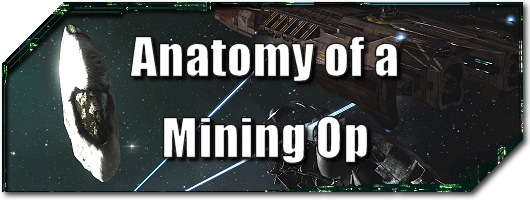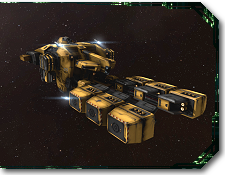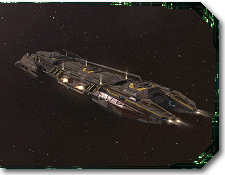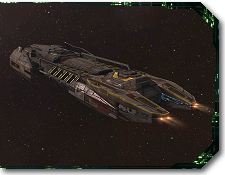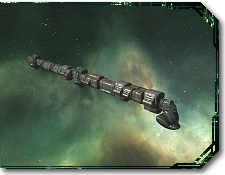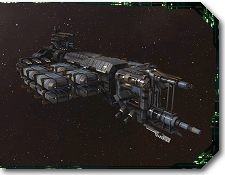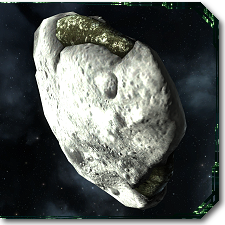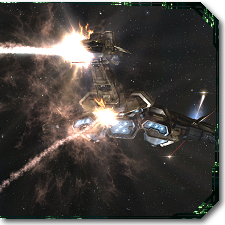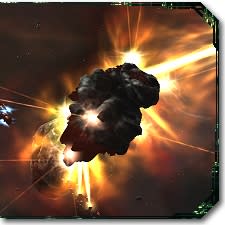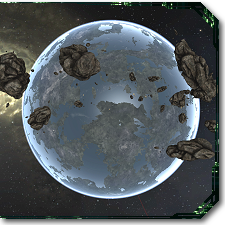EVE Evolved: Anatomy of a mining op
When EVE Online was first released in 2003, it was designed as a massive universe of competition and conflict between space-faring megacorporations in the distant future. Players bought into the premise completely and soon set about building their own empires and waging wars with neighbours. Corporations ran regular mining operations for resources to build frigates and cruisers for their members, and some of the larger corps co-operatively mined to build the first ever battleships in the game. The mining op has been a staple activity in the game ever since, providing a way for groups to work together on large manufacturing projects or just make some ISK during their down-time.
Mining gets a lot of flak for being one of the most boring and least profitable professions in the game, but that's not exactly true. Solo mining can be a great way to spend your downtime while doing other activities, and it ensures that you're online when something exciting happens like a live event, your wormhole system being invaded, or a titan being tackled by your alliance. Co-operative mining ops also offer the social value of bonding with your corpmates when there's nothing else going on. Some players even run dozens of accounts at the same time to turn this ordinarily placid activity into an intensive profit-making activity focused on efficiency and organisation skills.
With mining due to make a resurgence in the summer expansion, this edition of EVE Evolved is dedicated to the humble mining operation. I'll take a look at the various options for mining ships, the different haulers available, and the four different areas you can mine in.
The core of any mining op will be the mining ships, whose job is to hoover up rocks as quickly as possible without getting killed by nullsec NPCs, roaming pirates in lowsec, or potential suicide attacks in high-security space. Any combat ship with turret slots can technically mine by fitting a full rack of Miner IIs and fielding some mining drones, but over the years we've been given a number of specialised ships for the task. Players have speculated about plans for capital-sized mining ships for a number of years, but so far CCP has not revealed plans to add one.
The Venture
The ideal ship for new players to get started with is the nimble Venture mining frigate. It can pull in around 500m3 of ore per minute, has a specialised ore hold that can carry 5,000m3 of space rocks, and has two points of built-in warp core stabilisation to prevent warp scramblers from individual opportunistic pirates. In the event that it is destroyed, a new Venture costs only a few hundred thousand ISK, and the ship literally pays for itself in a few minutes of mining. The Venture is also the only ship with a bonus to gas harvesting, making it essential for wormhole ops.
The Covetor / Hulk
The Covetor and Hulk are the obvious ships of choice for a group mining op, provided that you have a dedicated hauler to collect the ore. They have the highest mining yields of all the barges but their ore holds need to be emptied every few minutes, and their weak tanks make them very vulnerable to suicide attacks and even attack by NPCs. You'll need some protection from a combat ship if you're mining in nullsec using a hulk, and if you're in a wormhole, then make sure the NPCs in the ore site have been killed before entering.
The Procurer / Skiff
If you're worried about suicide attacks in highsec or tanking NPCs in nullsec or a wormhole, the Procurer and Skiff sacrifice some mining yield for incredibly tough tanks. The tech 2 Skiff can reach around 100,000 effective hitpoints or can fit a 200-400 DPS active tank depending on how fat your wallet is. Both the Skiff and the tech 1 Procurer are much cheaper than the other barges, making them good throwaway ships for mining in dangerous territory. The Procurer is also often used as bait in PvP, and CCP plans to nerf its scan resolution to prevent its use as a tackler in gatecamps.
The Retriever / Mackinaw
Striking a balance between mining yield and defensive capabilities, the Retriever and Mackinaw are designed for solo mining. They have huge ore holds that need to be emptied roughly once every 15-20 minutes, making them ideal for AFK-mining while doing other activities.
In days gone by, players used to store their ore in a 27,500m3 temporary jettisoned container and then swap into a larger ship to haul the load back to the station. Today's mining ships have specialised ore holds that make this less necessary for solo miners, but it's still often the most effective way to mine in large groups. Players will collectively work together to fill up jettison containers and then rename them to indicate that they're full, at which point a hauler ship will empty the containers and bring the ore back to the station for reprocessing.
Industrial ships and freighters
The job of hauling used to fall exclusively to industrial ships like the Iteron Mk V and the Bestower, but today we have more effective tools for the job. Freighters and jump freighters can now access their cargo when in space and can store huge quantities of ore, but they aren't ideal haulers for mining ops. Not only are they slow and expensive to lose if the op is attacked, but they can't fit any modules such as tractor beams to pull in containers for loading and so must warp directly on top of the mining ships and slow-boat into range or have a helper ship tractor in cans.
The Orca
Designed to be a dedicated hauler for small- to medium-scale mining ops, the Orca has a total ore capacity of about 180,000m3. It has a special hangar that fleet members can deposit their ore into directly to completely eliminate the possibility of theft, along with a bonus to mining foreman gang links to increase the fleet's mining yield and range. The Orca also features tractor beam bonuses that allow it to quickly pull in full ore containers from a distance, and a bonus to survey scanner range lets the Orca pilot locate juicy asteroids for miners.
The Rorqual
The Orca's big brother, the Rorqual was originally designed to be used in massive nullsec mining ops in systems without a station. It has its own jump drive, capital ship sized tractor beams, and a unique ore compression system. The idea was that the Rorqual would compress ore during a mining op and then jump back to a station to deposit it. Things didn't exactly work out that way, however, as the expensive ship is rooted in place while compressing. Miners tend to ferry their ore to a starbase instead, and the Rorqual compresses it from the safety of the shield.
Conventional wisdom would tell you that mining in lowsec should be more profitable than in highsec and that nullsec should have both the greatest rewards and the greatest risk. The truth is that lowsec mining is currently the most profitable and there are plenty of opportunities to make big ISK mining for little or no extra risk.
High-security space
Events like Hulkageddon have convinced a lot of players that mining in highsec is just asking to be suicide ganked, but that's not really the case any more thanks to tough mining barges like the Skiff or a well-tanked Mackinaw. The best ores you'll find naturally in highsec are Kernite and Pyroxeres, but you can find more valuable lowsec ores like Hedbergite, Hemorphite, and Jaspet in ore sites. Just travel around highsec in a frigate with your probe scanner open and you'll eventually find a juicy ore site full of more valuable stuff to mine. If you're going to mine AFK in highsec, avoid Caldari space as Guristas NPCs will frustratingly use ECM to break your target locks.
Low-security space
Throw your common sense out the window because lowsec is actually more dangerous to mine in than nullsec. The past few years have seen a rise in the number of players hunting in lowsec, especially in interceptors that are now essentially unstoppable by gatecamps. The rewards may be worth the risk if you can find a quiet corner of lowsec to mine in, however, as some belts are full of Hedbergite, Jaspet, and Hemorphite. Due to the steady rise in Nocxium prices over the past few years, these are all worth more than the Arkanor, Bistot, and Crokite found in nullsec. The profitability of lowsec mining may increase with the summer expansion's reprocessing changes.
Wormhole space
Wormhole systems contain massive ore sites with rocks bigger than your ship and could be ideal for group strip-mining ops. Each site will contain asteroids of all types, making it possible to mine all the minerals needed for local production at a starbase. Getting ore out of wormholes is tricky, with some corps opting to compress it with a Rorqual and others refining it at a starbase. The biggest problems with mining in wormholes are that there's no local channel and that ore sites now show up as anomalies and don't need to be probed down. Cloaked ships can easily get the jump on your mining op, making it worthwhile to use cheaper tech 1 barges and implantless clones.
Null-security space
Many of the static asteroid belts in nullsec contain Arkanor, Bistot, and Crokite, which are supposed to be the most valuable ores in the game but are currently outshined by the Nocxium-containing lowsec ores. There's plenty of Hedbergite and Hemorphite to mine all over nullsec, and it's extremely low risk if you're part of the local nullsec alliance. It's also possible to sneak into nullsec through a wormhole and mine without being part of an alliance, but there's always a risk that you'll be discovered and destroyed.

Brendan "Nyphur" Drain is an early veteran of EVE Online and writer of the weekly EVE Evolved column here at Massively. The column covers anything and everything relating to EVE Online, from in-depth guides to speculative opinion pieces. If you have an idea for a column or guide, or you just want to message him, send an email to brendan@massively.com.

